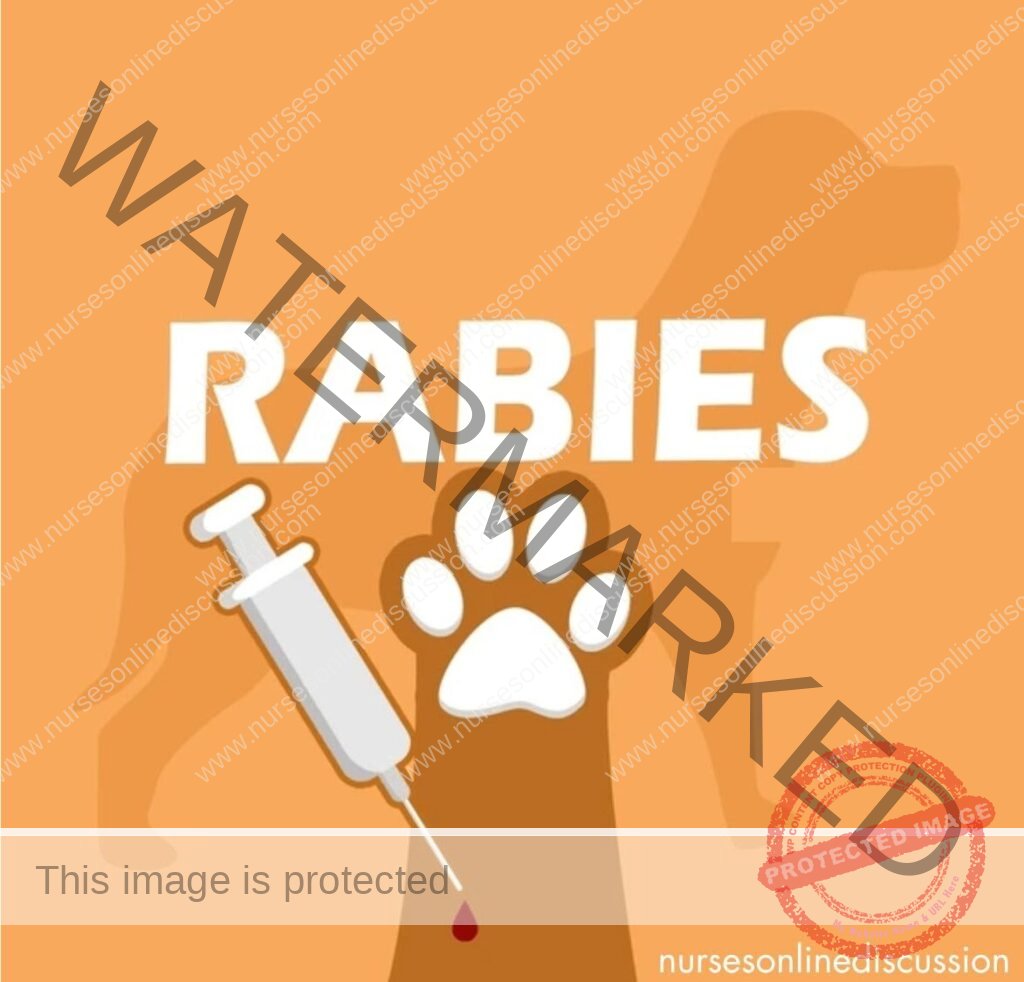Communicable Diseases
Subtopic:
Rabies

This refers to a viral zoonotic disease, meaning it is transmitted from animals to humans, that specifically targets the central nervous system (brain and spinal cord) of mammals.
Rabies is caused by the Rabies lyssavirus, a neurotropic virus, meaning it has a particular affinity for nerve tissue. Once clinical symptoms develop, the disease is almost invariably fatal.
Mode of Transmission
The virus is primarily transmitted through the saliva of an infected animal, most commonly via a bite.
However, transmission can also occur if saliva from an infected animal enters the body through scratches, abrasions, or comes into contact with mucous membranes like the eyes, nose, or mouth. Less common routes include inhalation of aerosolized virus, which might occur in caves heavily populated by infected bats, or through organ transplantation from an infected donor.
Common Animal Reservoirs
Globally, dogs are the most significant reservoir and source of human rabies deaths, accounting for up to 99% of all human transmissions.
In specific regions, such as the Americas and Europe, other important wildlife reservoirs include bats, raccoons, skunks, and foxes.
While livestock like cattle and horses can contract rabies, they are generally considered end-hosts, meaning they are unlikely to transmit the infection further.
Incubation Period
The time between exposure to the virus and the onset of symptoms, known as the incubation period, is highly variable.
It typically ranges from one to three months but can be as short as less than a week or extend beyond a year.
Several factors influence this period, including the location of the bite (exposures closer to the brain have shorter incubation periods), the severity of the exposure, the amount of virus introduced, and the infected individual’s immune status.
Symptoms (Clinical Manifestations)
The disease progresses through distinct phases:
Initially, a prodromal phase lasts about 2 to 10 days, characterized by non-specific symptoms such as fever, headache, malaise, and loss of appetite.
A key early indicator can be pain, tingling, or itching (paresthesia) at the site of the original wound.
This is followed by the acute neurological phase, lasting 2 to 7 days, which can manifest in two forms:
Furious Rabies: Affecting about 80% of cases, this form involves hyperactivity, agitation, confusion, and hallucinations. Patients may exhibit hydrophobia (fear of water), experiencing painful spasms of the throat and larynx when attempting to drink or even at the sight or sound of water. Aerophobia (fear of drafts) can also occur.
Paralytic (or “Dumb”) Rabies: Accounting for the remaining 20% of cases, this form is characterized by a more gradual onset of muscle weakness and paralysis, often starting at the bite site and spreading. Confusion and lethargy progress to coma. This form can sometimes be misdiagnosed.
Regardless of the form, the disease eventually progresses to coma and death, typically due to respiratory failure, within 7 to 10 days after symptoms begin.
Diagnosis
Diagnosing rabies in a living person (ante-mortem) is challenging, particularly in the early stages.
It often involves detecting the virus, its antigens, or nucleic acids in samples like saliva (using RT-PCR), skin biopsies (often from the nape of the neck, tested via direct fluorescent antibody test – dFAT), or cerebrospinal fluid (CSF). Antibodies in the serum or CSF of an unvaccinated individual can also be indicative.
A definitive diagnosis is usually made post-mortem by identifying rabies virus antigens (e.g., using dFAT) in brain tissue, or through virus isolation or RT-PCR on brain samples.
Prevention
Preventing rabies involves a multi-faceted approach:
Animal Control and Vaccination: The most effective strategy for preventing human rabies is the mass vaccination of dogs. This is often coupled with stray dog population management and the vaccination of domestic cats and ferrets.
Human Pre-Exposure Prophylaxis (PrEP): This involves administering a rabies vaccine series to individuals at high risk of exposure, such as veterinarians, animal handlers, laboratory personnel, and travelers to high-risk areas with limited medical access.
Awareness and Education: Public education on rabies risks, responsible pet ownership, avoiding contact with wild or unusually behaving animals, and the importance of reporting animal bites is crucial.
Post-Exposure Prophylaxis (PEP)
Immediate and thorough medical attention following a potential exposure to rabies is critical to prevent the onset of the disease.
PEP is highly effective if administered correctly and promptly before symptoms appear. It consists of:
Wound Care: Immediate and thorough washing of the wound for at least 15 minutes with soap and water, followed by the application of a virucidal agent like povidone-iodine or ethanol.
Rabies Immunoglobulin (RIG): Administered to individuals who have not been previously vaccinated against rabies. RIG provides immediate, passive immunity. It should be infiltrated into and around the wound(s) as much as anatomically feasible, with any remaining volume given intramuscularly at a site distant from vaccine administration.
Rabies Vaccine Series: A course of rabies vaccine injections administered on specific days (e.g., Days 0, 3, 7, and 14) to stimulate the body’s active immune response.
Prognosis
Once clinical symptoms of rabies manifest, the disease is nearly 100% fatal. Treatment is limited to supportive care, which does not alter the fatal outcome.
While a handful of human survival cases have been documented (often associated with intensive experimental treatments like the Milwaukee Protocol), these are exceedingly rare and survivors typically have severe, permanent neurological damage.
Related Topics
- Introduction to Communicable Diseases
- Measles
- Malaria
- Trypanosomiasis (Sleeping Sickness)
- Helminthic Diseases (Intestinal Worms)
- Onchocerciasis (River Blindness)
- Schistosomiasis
- Elephantiasis (Bancroftian Filariasis)
- Dracunculosis (Guinea Worm)
- Typhoid Fever
- Dysentery
- Cholera
- Brucellosis
- Ebola
- Yellow Fever
- Mumps (Parotiditis)
- Chicken Pox
- Rabies
- Tetanus
Get in Touch
(+256) 790 036 252
(+256) 748 324 644
Info@nursesonlinediscussion.com
Kampala ,Uganda
© 2025 Nurses online discussion. All Rights Reserved Design & Developed by Opensigma.co

